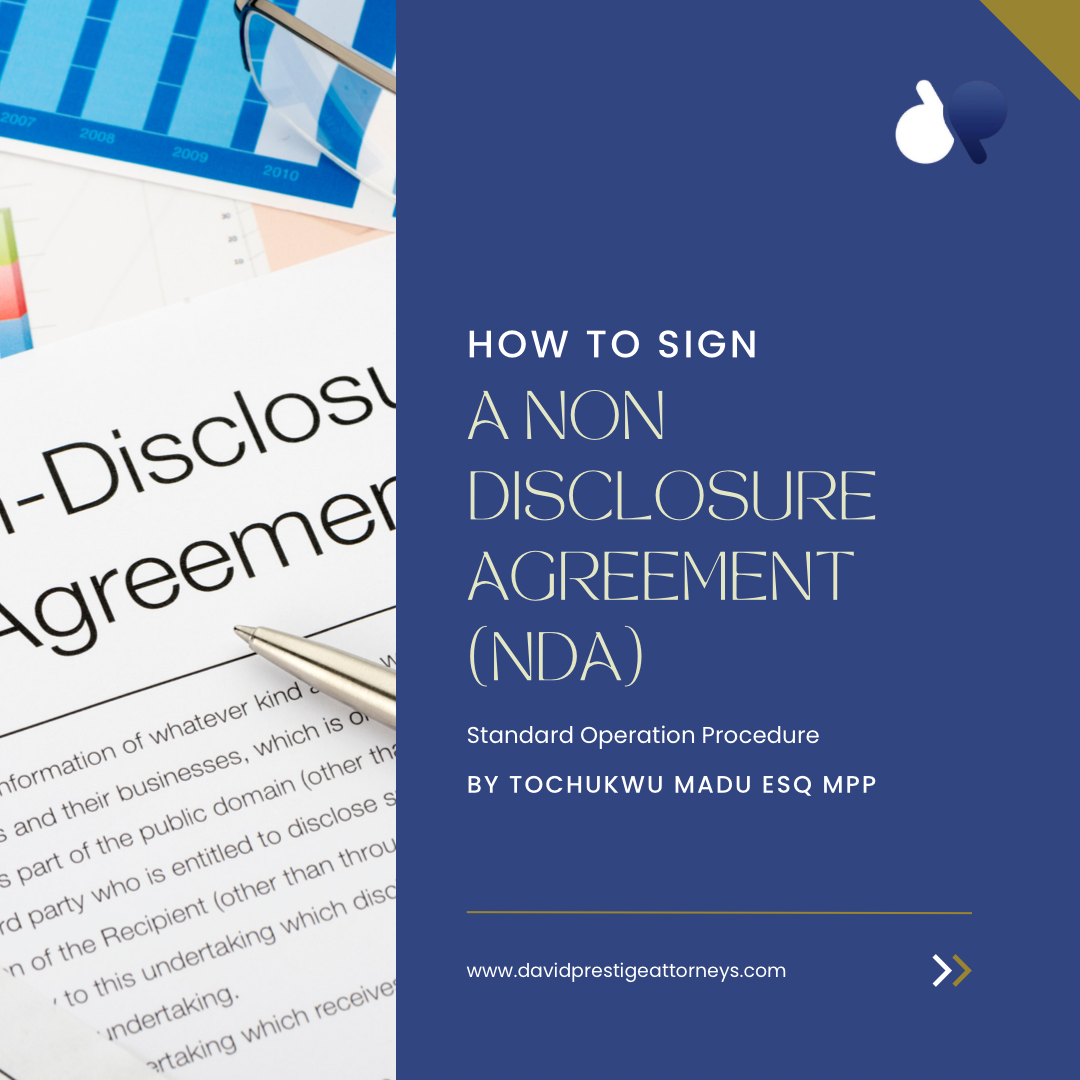Standard Operation Procedure
By Tochukwu Madu ESQ MPP
Purpose: The purpose of this piece is to educate readers on how to sign an NDA agreement and what to be aware of when signing an NDA agreement. NDA’s are used in business to protect vital business information like Intellectual Property or inside information during large corporate mergers.
Scope: Non-Disclosure Agreements are a common business practice, yet very few businesspeople fully understand the document before they sign them. So, this SOP will highlight the key procedure to follow when preparing to sign an NDA, from both sides of the business transaction. Use this guide next time you sign an NDA, and you will not fall victim to the pitfalls of these agreements. You can also use this guide to understand NDA agreements that businesses sign with their employees or with contractors.
Procedure: Follow this step by step guide to understand and fully comprehend the reach as well as the legal ramifications of the NDA you are signing. Party A is the legal entity that is requesting that Party B signs the NDA agreement.
1) Read the NDA properly:
An NDA is often a 2 to 3-page document and as such it often is signed without parties reading the clauses properly. As with any contractual agreement you must read the entire document properly before you put pen to paper.
2) Standard Clauses:
The standard clauses of an NDA are the definitions and identification of the parties that are signing the NDA.
● Make sure that your business name and details are correct before signing the agreement. You could become liable for penalties if your company details are not correct or even spelled incorrectly.
● Confirm that the person signing the NDA is the properly authorized company officer from both parties or it could lead to severe legal and financial consequences.
● Confirm the PARTY A and PARTY B company details and signatory information is 100% legally correct.
● Ensure that the NDA covers any future name changes or amalgamation of the parties signing the agreement. This will enable you to track the usage of your shared information by PARTY B even if they change their legal name and that PARTY A will be in control of the confidential information as desired.
3) Confidential Information Clauses:
Before signing the NDA, you must ensure that the confidential information covered by the NDA is properly defined so that there is no ubiquity. Regardless of what the confidential content is of the NDA, you must be clear about the reach and context of the information that is being shared.
● Review the confidential information to clarify that you have all the relevant details that you are signing for.
● Ensure that you are aware of the potential applications of this information before you sign so that you can prevent an accidental breach of NDA.
● PARTY A is sharing confidential information with PARTY B; thus, PARTY B must get a detailed specification sheet to fully understand what the impact of this information would be to their company.
● Ensure that the confidential information details are not overextended, meaning the definitions are broad and could lead to difficulties in the future.
● Ensure that there is no TRANSFER OF INTELLECTUAL PROPERTY in the NDA so that your IP stays your property.
4) Term of the NDA Agreement:
When reviewing the NDA agreement, it is vital to clarify the term period of the agreement. Technology changes and unique ideas of today will not be unique ideas of tomorrow.
● Review the terms of the agreement to ensure that you (PARTY B) are not signing a never-ending NDA and that you would be released from the terms after a certain period.
● If you make the time frame of the agreement too long (PARTY A), you will have difficulty litigating the agreement in court due to statute of limitation concerns.
Please Note: in the case of trade secrets most NDA might have a perpetual time frame. This is normal in most cases, but you still must be aware of the impact of the timeframe on your business
5) Legal Implications of NDA:
Apply these principles when reading the NDA agreement and you will have peace of mind next time you sign an NDA. In every case, you must review the legal stipulation of the NDA so that you can ensure that it complies with your region or location laws and regulations.
In the event of a lawsuit you must understand the following stipulations:
● Where will the case be tried? You might have to travel long distances to attend the trial so you might want to enquire about an alternative location.
● Who will be responsible for the payment of legal fees? It is often the case that the losing party becomes liable for the legal fees.
Mutual or Unilateral NDA
● A mutual NDA requires both parties to keep all information shared under the authority of the NDA confidential.
● If the agreement is not mutual it is advisable for PARTY B to negotiate mutual nondisclosure with PARTY A.
Residuals Clauses
● Review this clause to clarify the extent to which you can use the information that you have learned under the authority of the NDA.
● Review the sharing method stipulated in the NDA of the confidential information, will it be by Email, Physical Documentation, or other electronic formats.
Damages Calculation
● Review the calculation that will be used to determine the damages as defined by the NDA. PARTY B must understand what the consequences will be in the event of a breach.
If you follow this guide you will have a much better experience next time you sign an NDA agreement. Whether you are PARTY A or PARTY B you will now be able to better sign your NDA documentation.

